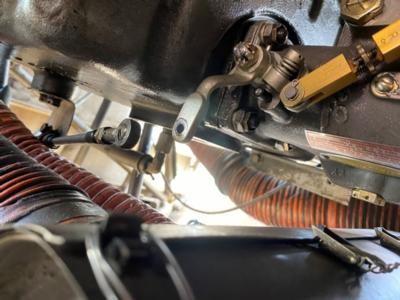Wed, Aug 05, 2020
Throttle Control Was Very Loose When Moved By Hand In The Cockpit
Location: Burns Flat, OK Accident Number: CEN20LA292
Date & Time: 07/18/2020, 2245 CDT Registration: N3412C
Aircraft: Beech A23-24 Injuries: 4 None
Flight Conducted Under: Part 91: General Aviation - Personal

On July 18, 2020, about 2245 central daylight time, a Beech A23-24 airplane, N3412V, was substantially damaged when it was involved in an accident near Burns Flat, Oklahoma. The pilot and his 3 passengers were not injured. The airplane was operated as a Title 14 Code of Federal Regulations Part 91 personal flight.
The pilot reported that while established in cruise flight the airplane experienced a gradual loss of engine power. He was unable to restore engine power by switching fuel tanks, turning on the fuel boost pump, and advancing the throttle, mixture, and propeller controls full forward. The pilot stated that he turned on the landing light and made a forced landing in a grass field. The pilot reported that after touchdown the airplane traversed over 3 large terraces, and that the main landing gear collapsed when he tried to swerve the airplane to avoid a tree. The horizontal stabilizer and both wings were substantially damaged during the forced landing.
The airplane was examined at the accident site by a Federal Aviation Administration airworthiness inspector. Both wing fuel tanks contained about 25 gallons of 100 low-lead aviation fuel. The throttle control was very loose when moved by hand in the cockpit. A visual inspection of the fuel servo revealed that the throttle linkage was not connected to the throttle control rod-end. The retaining bolt, washer, and self-locking nut were not located during the investigation.

The airplane had accumulated 8.72 hours since the last annual inspection that was completed on October 22, 2019. The inspection authorized (IA) mechanic who had completed the annual inspection stated that the fuel servo had been removed from the engine and overhauled in conjunction with the annual inspection. The IA mechanic stated that he personally reinstalled the overhauled fuel servo on the engine, while another individual moved the throttle and mixture controls in the cockpit. The IA mechanic stated that it is his standard practice to connect both the throttle and mixture controls to the fuel servo at the same time. The IA mechanic stated that he likely reused the bolt and washer to connect the throttle control rodend to the fuel servo throttle linkage, and that it is possible that he also reused the self-locking steel nut. However, he would not have reused the self-locking nut if it had fully engaged the bolt threads by hand. The IA mechanic stated that he used two wrenches to secure the
selflocking nut and that he did not use a torque wrench. A review of the Beech A23-24 Maintenance Manual revealed no specific assembly instructions on how to physically connect the throttle control rod-end to the fuel servo throttle linkage. The Beech A23-24 Illustrated Parts Catalog specified that the throttle control rod-end be attached to the fuel servo throttle linkage with a 169-910021 bolt, AN960-10 washer, and MS20365-1032 self-locking nut.
More News
Aero Linx: Model Aeronautical Association of Australia MAAA clubs are about fun flying, camaraderie and community. For over 75 years, the MAAA has been Australia’s largest fl>[...]
Touchdown Zone Lighting Two rows of transverse light bars located symmetrically about the runway centerline normally at 100 foot intervals. The basic system extends 3,000 feet alon>[...]
“Discovery and innovation are central to our mission at Virgin Galactic. We’re excited to build on our successful record of facilitating scientific experiments in subor>[...]
How To Get A Story On Aero-TV News/Feature Programming How do I submit a story idea or lead to Aero-TV? If you would like to submit a story idea or lead, please contact Jim Campbel>[...]
Student Pilot Reported That During Rotation, “All Of A Sudden The Back Of The Plane Kicked To The Right..." Analysis: The student pilot reported that during rotation, “>[...]
 ANN's Daily Aero-Linx (05.02.24)
ANN's Daily Aero-Linx (05.02.24) ANN's Daily Aero-Term (05.02.24): Touchdown Zone Lighting
ANN's Daily Aero-Term (05.02.24): Touchdown Zone Lighting Aero-News: Quote of the Day (05.02.24)
Aero-News: Quote of the Day (05.02.24) ANN FAQ: Contributing To Aero-TV
ANN FAQ: Contributing To Aero-TV NTSB Final Report: Cirrus Design Corp SR20
NTSB Final Report: Cirrus Design Corp SR20




